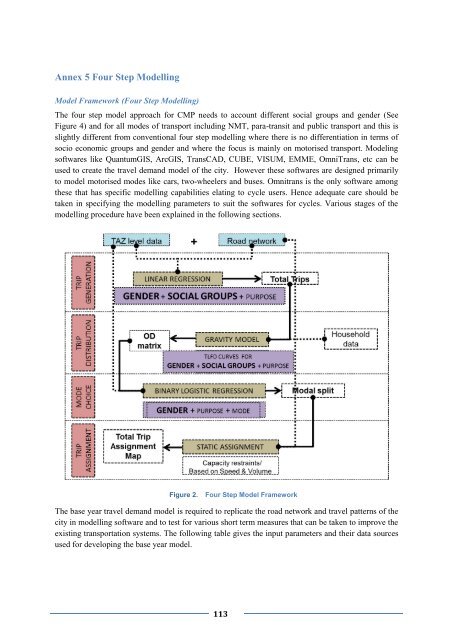Toolkits for Urban Transport Development - UNEP
Toolkits for Urban Transport Development - UNEP
Toolkits for Urban Transport Development - UNEP
Create successful ePaper yourself
Turn your PDF publications into a flip-book with our unique Google optimized e-Paper software.
Annex 5 Four Step Modelling<br />
Model Framework (Four Step Modelling)<br />
The four step model approach <strong>for</strong> CMP needs to account different social groups and gender (See<br />
Figure 4) and <strong>for</strong> all modes of transport including NMT, para-transit and public transport and this is<br />
slightly different from conventional four step modelling where there is no differentiation in terms of<br />
socio economic groups and gender and where the focus is mainly on motorised transport. Modeling<br />
softwares like QuantumGIS, ArcGIS, TransCAD, CUBE, VISUM, EMME, OmniTrans, etc can be<br />
used to create the travel demand model of the city. However these softwares are designed primarily<br />
to model motorised modes like cars, two-wheelers and buses. Omnitrans is the only software among<br />
these that has specific modelling capabilities elating to cycle users. Hence adequate care should be<br />
taken in specifying the modelling parameters to suit the softwares <strong>for</strong> cycles. Various stages of the<br />
modelling procedure have been explained in the following sections.<br />
Figure 2.<br />
Four Step Model Framework<br />
The base year travel demand model is required to replicate the road network and travel patterns of the<br />
city in modelling software and to test <strong>for</strong> various short term measures that can be taken to improve the<br />
existing transportation systems. The following table gives the input parameters and their data sources<br />
used <strong>for</strong> developing the base year model.<br />
113
















